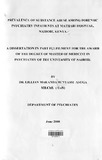| dc.description.abstract | Psychiatric patients with both major mental illnesses and substance abuse disorders have more extensive criminal histories and demonstrate a higher level of risks and needs when compared with patients with major mental illness alone. Despite the growing awareness of the unique needs of psychiatric patients with co-occurring substance abuse disorders (i.e. dual diagnosis), little work has been done in Africa, and Kenya in particular to investigate the prevalence and implications of dual diagnosis in forensic psychiatry patients. Objectives: To determine the prevalence of substance abuse, associated sociodemographic characteristics, other psychiatric comorbidity and relationship between substance abuse and nature of index offence among forensic psychiatry inpatients at the Maximum Security Unit (MSU), Mathari Hospital, Nairobi, Kenya.
Design: A cross-sectional population study using entire population of the Maximum Security Unit who satisfied the inclusion criteria was used.
Setting: The study was carried out at Mathari Hospital, Nairobi, Kenya.
Methods: The study sample comprised of 135 forensic inpatients who met the inclusion criteria. They were interviewed using structural instruments to collect sociodemographic and substance use information (ASSIST) as well as to make psychiatric co-diagnoses based on DSM-IVTR (SCID). Descriptive and inferential analysis was done using the Statistical Package for Social Sciences (SPSS) Version 11.5 and results presented in narratives and tables.
Results: The 135 participants were aged between 18 and 84, mean age being 37 years. One hundred and eighteen (87.4%) were male and majority were single (51.1 %) or married (28.9%). The highest percentage resided in Eastern province (29.6%) and Central province (25.2%)
before arrest, and most were Protestant (45.2%) or Catholic (41.5%). Majority of the participants (54.8%) had attained primary level as their highest level of education with 44.4% being unemployed and 27.4% being in the informal employment sector. A family history of mental illness was found in 26.5%. Sixty-seven (51.1 %) had history of previous admission and majority of these (77.9%) had been admitted for months. Most previous admissions were civil in nature (56.5%). The study population had a substance abuse prevalence rate of74.8%, tobacco products being the most frequently abused substance (58.5%), followed by alcoholic beverages (48.1 %) and cannabis (31.9%), amphetamine-type stimulants (23.0%), caffeine (3.0%), sedatives (3.0%) and cocaine and inhalants 2.2% each.
Violent offences were the most commonly occurring index offence (68.1 %) followed by criminal damage (18.5%), sexual offences (8.1%) and theft and handling of stolen goods (5.2%). Psychiatric comorbidity was found to be Depressive episodes 46.2%, Schizophrenia 42.3%, Past episodes of Mania 17.6% and Dysthymic disorder 15.3%.
There was a statistically significant association (p<0.05) between substance abuse and sex/gender (p=0.002), occupation (p=0.036) and nature of previous admission (p=0.029) whereas there was no association (p>0.05) between substance abuse and age, residence, religion, highest level of education, marital status, family history of mental illness, history of previous admission, number of previous admissions and duration of previous admissions.
There was a statistically significant association (p<0.05) between nature of index offence and the use of tobacco (p=0.033) and amphetamine-type stimulants (p=0.009). However, there was no statistically significant association (p >0.05) between substance abuse in general and nature of index offence.
Conclusions: Firstly, there is a high prevalence of substance abuse (74.8%) among forensic psychiatry inpatients at MSU, Mathari Hospital, Nairobi, the most commonly abused substance being tobacco products. This coupled with low screening rates could have an important impact on the quality of treatment provided, including missing opportunities for substance abuse intervention.
Secondly, it is universally agreed that majority of mentally-ill patients who are receiving appropriate treatment do not carry a greater risk of violence than the general population. However, major determinants for violence were found to include: sociodemographic (male gender) and socioeconomic factors (low levels of employment) as well as substance abuse (particularly of tobacco products and amphetamine-type stimulants).
Thirdly, early identification and treatment of substance use problems in the mentally ill can thus significantly reduce the risk of violence.
Finally, depressive illness is the most common co-occurring major mental disorder in the forensic inpatients and its comorbid existence with substance abuse must be actively sought out and treated.
Recommendations: Firstly, staff in mainstream and forensic mental health services, particularly admitting psychiatrists, urgently need training in detecting and managing substance abuse. "To
overlook or neglect substance abuse in the course of mental health treatment will result in poor treatment outcome."ss
Secondly, rehabilitative services need to be expanded to accommodate the large number of Forensic patients with substance abuse problems. Setting up a rehabilitation ward/unit within the Maximum Security Unit would go a long way to this end. | en_US |


